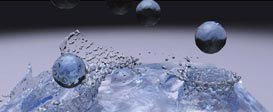Light Interaction With Human Skin: From Believable Images to Predictable Models
![]() Full Conference
Full Conference ![]() One-Day Full Conference
One-Day Full Conference
Wednesday, 10 December, 13:45 - 17:30
Room 305
Level: Intermediate
This course on biophysically based models of light interaction with skin tissues provides details and interdisciplinary concepts often omitted from publications. The emphasis of the course is on scientific issues that need to be addressed in rendering of realistic and predictable images of human skin.
Recent research in image synthesis has focused on rendering of believable and predictable images of biological materials. This course addresses an important topic in this area: predictive simulation of skin appearance. The modeling approaches, algorithms, and data examined during this course can be also applied to rendering other organic materials such as hair and ocular tissues.
The first module of the course provides the biophysical background required not only for development of models of light interaction with organic materials, but also for their evaluation. It begins with a review of optics and "measurement-of-appearance" concepts, followed by a presentation of biological factors involved in the processes of light propagation and absorption in skin tissue. A concise review of modeling approaches used in biomedical and related fields, and often cited by computer graphics researchers, completes this module. The second module provides detailed descriptions of computer graphics models of light interaction with human skin, including approaches to practical issues involving their implementation and analysis of their strengths and limitations. Recent developments involving these models, such as extensions, applications, and more accurate or efficient versions, are also examined. The course concludes with a discussion of current and future challenges related to rendering human tissues.
Prerequisites
Familiarity with basic optics concepts and radiometric terms. Attendees should have a working knowledge of standard graphics techniques and terminology. Experience with numerical methods is helpful, but not required.
Intended Audience
Students, practitioners, and researchers interested in rendering, biomedical imaging, and natural phenomena.
Instructors
Gladimir Baranoski
University of Waterloo
Aravind Krishnaswamy
Adobe Systems Incorporated
Instructor Bios
Gladimir Baranoski
Gladimir Baranoski is an associate professor in the School of Computer Science, University of Waterloo. He is also a member of the Executive Committee of the Eurographics Association. He has organized and presented several tutorials for international conferences, including SIBGRAPI, SIGGRAPH, EUROGRAPHICS, and AFRIGRAPH.
Aravind Krishnaswamy
Aravind Krishnaswamy is a senior graphics researcher with the Visual Computing Lab at Adobe Systems.The results of his research on the interaction of light with human skin have been presented in several publications and tutorials, including SIBGRAPI 2004, EUROGRAPHICS 2005, and AFRIGRAPH 2007.








